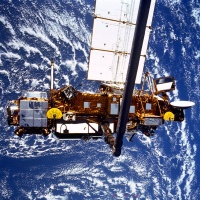UARS
From The Space Library
 | |
| Organization | NASA-Office of Space Science Applications (United States) |
|---|---|
| Mission type | Astronomy,Earth Science,Solar Physics,Space Physics |
| Launch date | September 12, 1991 |
| Launch vehicle | STS-48 |
| Carrier rocket | Space Shuttle |
| Launch site | Cape Canaveral, United States |
| COSPAR ID | 1991-063B |
| Mass | 6540.0 kg |
| Experiments | Here |
| Alternate Names | Upper Atmosphere Research Satellite, 21701 |
| Nominal Power | 1600.0W |
| Additional Information | Here |
| PDMP Information | Here |
| Telecommunications Information | Here |
| Data Collection | {$Data Collection} |
The Upper Atmosphere Research Satellite (UARS), an element in NASA's Mission to Planet Earth, was launched from the Shuttle (STS 48) to provide data for better understanding of the Earth's upper atmosphere and the effects of natural and human interactions on the atmosphere. The objectives of the UARS mission were to conduct research in the atmosphere above the tropopause by measuring the global budget of constituent trace gases and their chemical, dynamic,and radiative behavior. UARS had two major components: an instrument module containing the ten instruments and mission unique components, and a multimission modular spacecraft (MMS). The MMS included the Communications and Data Handling (C&DH) subsystem, the Modular Attitude Control Subsystem (MACS), the Modular Power Subsystem (MPS), the Signal Conditioning and Control Unit (SC&CU), and the Propulsion Module. The C&DH provided communications, command and control of the spacecraft and instruments, acquistion and storage of science and housekeeping data, and central computation facilities. The MACS provided attitude determination and control. The MACS subsystem maintained the Earth-oriented three-axis stability of the spacecraft through the use of star trackers, an inertial reference unit, three-axis magnetometers, a Fine Sun Sensor assembly, an Earth Sensor Assembly, and a Coarse Sun Sensor assembly, as well as momentum wheels, magnetic torquers, and attitude control thrusters. Power was maintained by a six-panel solar array and three 50 A-hour batteries. The power subsystem also consisted of the MPS, regulators, solar array drive (which had some problems during summer 1992), solar array drive electronics, and power transfer assemblies. The instrument complement for UARS consisted of nine instruments devoted to the primary atmospheric mission plus one announcement-of-opportunity instrument, the Active Cavity Radiometer Irradiance Monitor II (ACRIM II). The nine primary instruments were: (1) Cryogenic Limb Array Etalon Spectrometer (CLAES); (2) Improved Stratospheric and Mesospheric Sounder (ISAMS); (3) Microwave Limb Sounder (MLS); (4) Halogen Occultation Experiment (HALOE); (5) High Resolution Doppler Imager (HRDI); (6) Wind Imaging Interferometer (WINDII); (7) Solar Ultraviolet Spectral Irradiance (SUSIM); (8) Solar Stellar Irradiance Comparison Experiment (SOLSTICE); and, (9) Particle Environment Monitor (PEM). There were also ten UARS investigators performing theoretical investigations.
